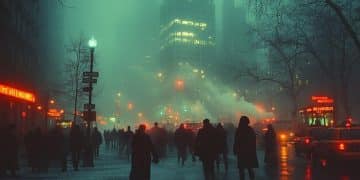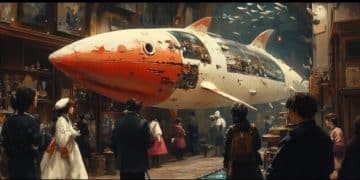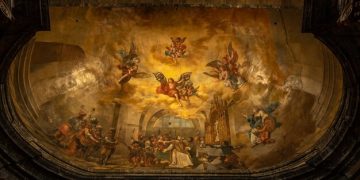Rediscovering Silent Cinema: A Deep Dive into Forgotten Masterpieces
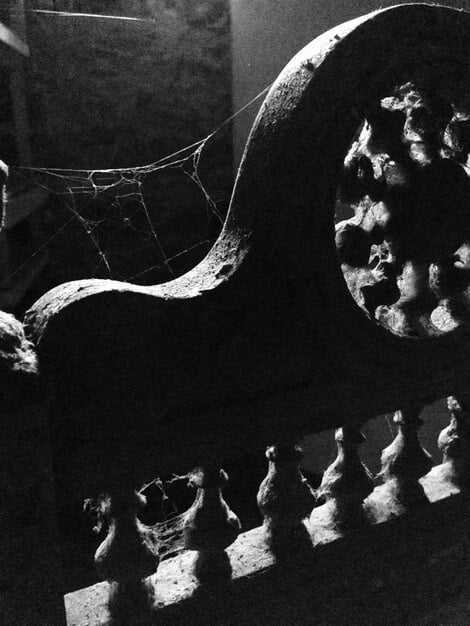
Silent cinema, a period of filmmaking from the late 19th century to the late 1920s, represents a pivotal era in film history, rich with innovative storytelling, visual expression, and the birth of iconic stars, often overlooked in modern discussions of cinema.
Step back in time to an era where storytelling relied purely on visuals and emotion—the era of silent cinema. While often overshadowed by the talkies, this period produced a wealth of cinematic masterpieces that continue to resonate with their artistry and innovation.
The Dawn of Cinema: Understanding Silent Film’s Origins
Silent films, produced from the late 1800s until the advent of synchronized sound in the late 1920s, weren’t truly “silent.” They were typically accompanied by live music, often performed on a piano or organ in the theater, and sometimes included intertitles to convey dialogue or narration.
This era gave rise to many foundational techniques and styles in filmmaking that continue to influence cinema today.
Early Innovations in Storytelling
The absence of dialogue forced filmmakers to become incredibly creative with visual storytelling.
- Physical comedy: Exaggerated gestures and facial expressions became essential tools for conveying humor.
- Melodrama: Intense emotional displays were used to engage audiences and communicate complex narratives.
- Visual metaphors and symbolism: Filmmakers incorporated visual cues to add layers of meaning and depth to their stories.
Silent films were far from primitive; they were a dynamic and evolving art form that laid the groundwork for modern cinema.
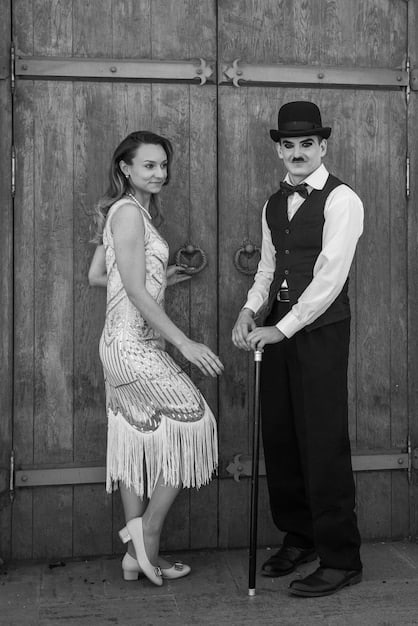
Pioneering Figures: The Visionaries Behind the Lens
The silent era was defined by a host of talented individuals who pushed the boundaries of filmmaking. These pioneers developed distinct styles and techniques that cemented their place in film history.
Let’s explore some key figures who shaped the landscape of silent cinema.
Charlie Chaplin: The Tramp and His Enduring Legacy
Charlie Chaplin, known for his iconic “Tramp” character, was a master of comedy and social commentary.
- Physical comedy: Chaplin’s routines were perfectly timed and executed.
- Social satire: His films often critiqued societal inequalities and the struggles of the working class.
- Directorial control: Chaplin was known for his meticulous control over every aspect of his films, contributing to their lasting appeal.
D.W. Griffith: The Birth of a Nation and Its Controversies
D.W. Griffith was a technically innovative director, though his work is often viewed through the lens of controversy due to the racial stereotypes in “The Birth of a Nation.”
Fritz Lang: Expressionism and Metropolis
Fritz Lang, a German-Austrian filmmaker, brought a sense of visual and thematic grandeur to silent cinema.
- Expressionist design: Lang’s use of striking visual elements created a sense of unease and tension.
- Social commentary: “Metropolis” explored themes of class division and the dangers of unchecked industrial progress.
- Pioneering special effects: The film’s groundbreaking effects set a new standard for cinematic spectacle.
These figures, with their distinct approaches, elevated silent cinema to new heights, leaving behind a legacy that continues to inspire filmmakers today.
Narrative Innovation: How Silent Films Told Stories
Without spoken dialogue, silent films relied on innovative storytelling techniques to convey narratives and emotions. These methods, born out of necessity, became hallmarks of the era.
Let’s delve into the different ways silent films engaged their audiences.
Intertitles: The Voice of Silent Cinema
Intertitles were an essential storytelling device, providing dialogue, exposition, and character thoughts.
They helped clarify plot points and provided crucial context in the absence of spoken words.
Visual Storytelling: Actions Speak Louder Than Words
Silent films utilized visual cues, expressions, and gestures to convey emotions and narratives.
Actors’ nuanced performances were crucial in communicating complex emotions and plot developments.
Pantomime and Physicality
Exaggerated movements and facial expressions were a staple of silent film acting.
This physicality added a layer of dynamism to the storytelling, making it engaging and universally understandable.
The Art of Slapstick: Comedy in the Silent Era
Slapstick comedy, characterized by exaggerated physical humor and absurd situations, flourished during the silent era. This style of comedy relied on visual gags and farcical scenarios to entertain audiences.
Let’s explore some of the key elements of slapstick and its prominent figures.
Key Characteristics of Slapstick
Slapstick comedy thrives on:
- Exaggerated physical comedy: Actors often engaged in absurd and over-the-top physical actions.
- Farce: Slapstick situations were often ridiculous and improbable, creating comedic effect.
- Visual gags: Silent films used visual tricks and comedic props to enhance the humor.
Buster Keaton: The Great Stone Face
Buster Keaton, known as “The Great Stone Face” for his stoic expressions, was a master of physical comedy and inventive stunts.
Harold Lloyd: The Everyman Comedian
Harold Lloyd created relatable characters who often found themselves in precarious and hilarious situations.
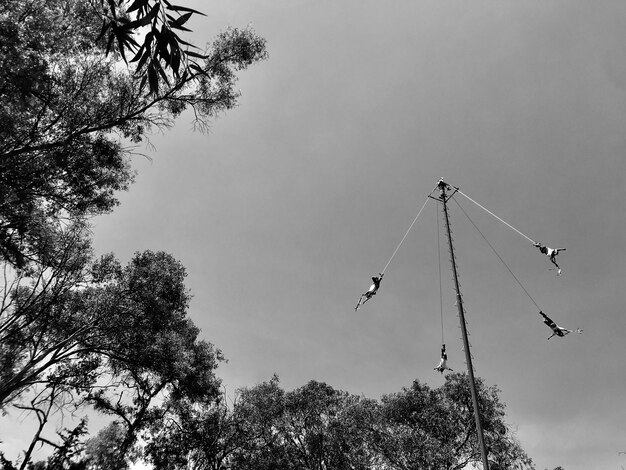
Forgotten Gems: Must-See Silent Films
While some silent films are widely celebrated, many masterpieces remain relatively unknown. These hidden gems offer unique cinematic experiences and insights into the era.
Let’s uncover some essential yet often overlooked silent films.
“Safety Last!” (1923) – Harold Lloyd
“Safety Last!” is famous for its iconic scene of Harold Lloyd dangling from a clock tower.
This film is a perfect example of silent comedy with thrilling stunts and relatable characters.
“The Passion of Joan of Arc” (1928) – Carl Theodor Dreyer
Carl Theodor Dreyer’s “The Passion of Joan of Arc” is a powerful and emotionally intense historical drama.
The film is renowned for its close-up shots and the haunting performance of Renée Jeanne Falconetti.
“The Last Laugh” (1924) – F.W. Murnau
F.W. Murnau’s “The Last Laugh” is a visually stunning film that tells the story of a hotel doorman who loses his job.
The film is notable for its fluid camera movements and innovative storytelling techniques.
The Transition to Sound: The End of an Era
The late 1920s marked the end of the silent era as synchronized sound became the new standard in filmmaking. This transition had a profound impact on the industry, leading to both advancements and challenges.
Let’s explore the events that led to this seismic shift in cinema.
“The Jazz Singer” (1927): The First Talkie
“The Jazz Singer,” released in 1927, is widely regarded as the first feature-length “talkie,” featuring synchronized dialogue and musical numbers.
This film demonstrated the commercial potential of sound and set the stage for the widespread adoption of sound technology.
Impact on Actors and Filmmakers
The transition to sound presented new challenges for actors, many of whom struggled to adapt to the demands of dialogue and vocal performance.
Filmmakers had to learn new techniques for recording sound and integrating it into their narratives.
The Legacy of Silent Film Techniques
Despite the advent of sound, many of the visual storytelling techniques developed during the silent era continued to influence filmmaking.
Techniques such as expressive acting, camera movement, and editing remain integral to modern cinema.
| Key Point | Brief Description |
|---|---|
| 🎬 Origins | Emerged in the late 1800s, relying on visual storytelling. |
| 🎭 Key Figures | Chaplin, Griffith, and Lang shaped the era with unique styles. |
| 😂 Slapstick | Comedy thrived with Keaton and Lloyd, focusing on physical humor. |
| 🔈 Transition | “The Jazz Singer” (1927) marked the shift to sound films. |
FAQ on Silent Cinema
▼
Silent cinema refers to films made without synchronized sound for dialogue, typically produced from the late 19th century to the late 1920s. These films relied heavily on visual storytelling.
▼
Key figures include Charlie Chaplin, known for his “Tramp” character, D.W. Griffith, noted for technical innovation, and Fritz Lang, celebrated for visual and thematic grandeur.
▼
Silent films used intertitles for dialogue and exposition, relied on expressive acting and physical movements, and employed visual metaphors to communicate complex emotions and plot.
▼
Forgotten gems include “Safety Last!” (1923) by Harold Lloyd, “The Passion of Joan of Arc” (1928) by Carl Theodor Dreyer, and “The Last Laugh” (1924) by F.W. Murnau.
▼
The release of “The Jazz Singer” in 1927 marked the end of silent cinema. The advent of synchronized sound led to new challenges, requiring actors and filmmakers to adapt to new technology.
Conclusion
Exploring the world of silent cinema reveals a treasure trove of artistic innovation and compelling storytelling. By revisiting these forgotten masterpieces, we gain a deeper appreciation for the foundations of modern filmmaking and the creative pioneers who shaped the art form.
